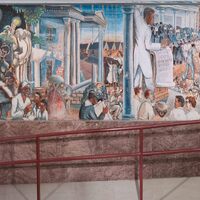"The History of the Negro in Education" by Abe Washington

Abe Washington’s mural traces a detailed timeline of progress for Black people in the United States from the left to the right of the painting. It begins with a group of hooded Klansmen burning a church and lynching two Black men. Further right, a missionary holds books and an enslaved family learns to read. Above their heads, a group of Union soldiers hold torches and march forward. Towards the center of the mural, a Black woman teaches a pair of children to read; behind them, another woman washes clothing in front of a large, but crumbling, plantation house. Next, a white teacher instructs a group of Black children; the words “EMANCIPATION PROCLAMATION” are written on their chalkboard, below a small portrait of President Abraham Lincoln. Below them, soldiers scout territory and a group of Black adults also practice reading. To the right, Booker T. Washington stands prominently at a podium, lecturing to a diverse crowd, as a scroll reading “CAST DOWN YOUR BUCKETS WHERE YOU ARE” tumbles down. A long line of Black graduates extends from his podium, then trails off into scenes of farming and construction. At the far right, a variety of Black professionals, including a judge, a doctor, scientists, and an architect, are pictured at work in their respective fields.
Washington’s mural presents a linear narrative of progress for Black Americans out of slavery into the industrial 1950s. It also emphasizes education as the key factor in advancing Black interests and rights. Accordingly, Booker T. Washington is featured prominently. Washington, the founder of the Tuskegee Institute, now Tuskegee University, believed education and accommodation were needed for racial equality to be achieved. He articulated his vision in his 1895 “Atlanta Compromise” speech to the Cotton States and International Exposition, which the artist portrays in his mural, from which the phrasing of “cast down your buckets” originates. Abe Washington set out, in his own words, to illustrate “the story of Black people's ambition in the South and the things that influenced their lives.” When he returned to Texas Southern’s campus in 2015, decades after completing his mural, he felt proud of his artwork. Reflecting, he expressed “hope that we can all keep our eyes on the prize."
This program is made possible in part by a grant from Humanities Texas, the state affiliate of the National Endowment for the Humanities.
